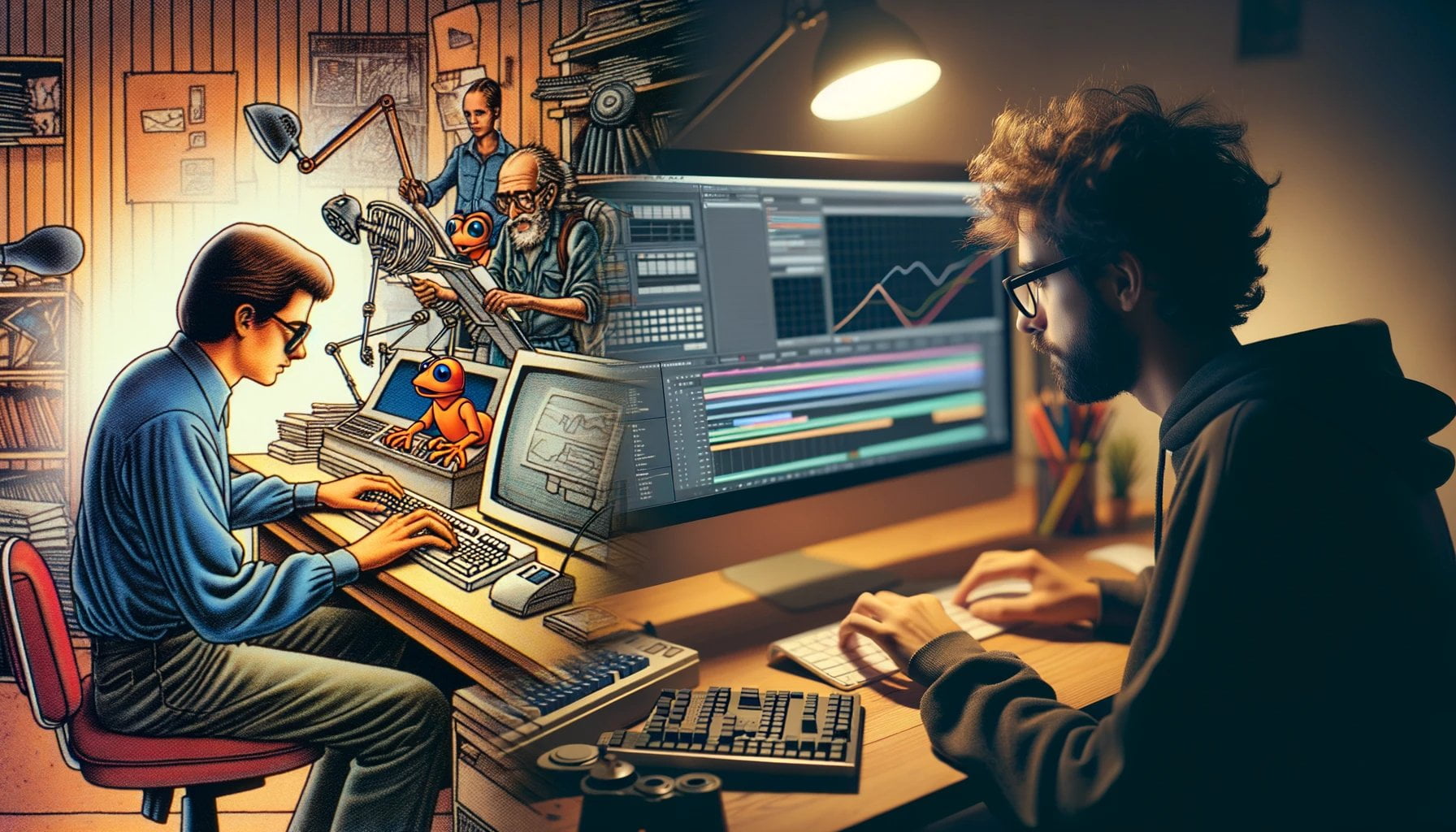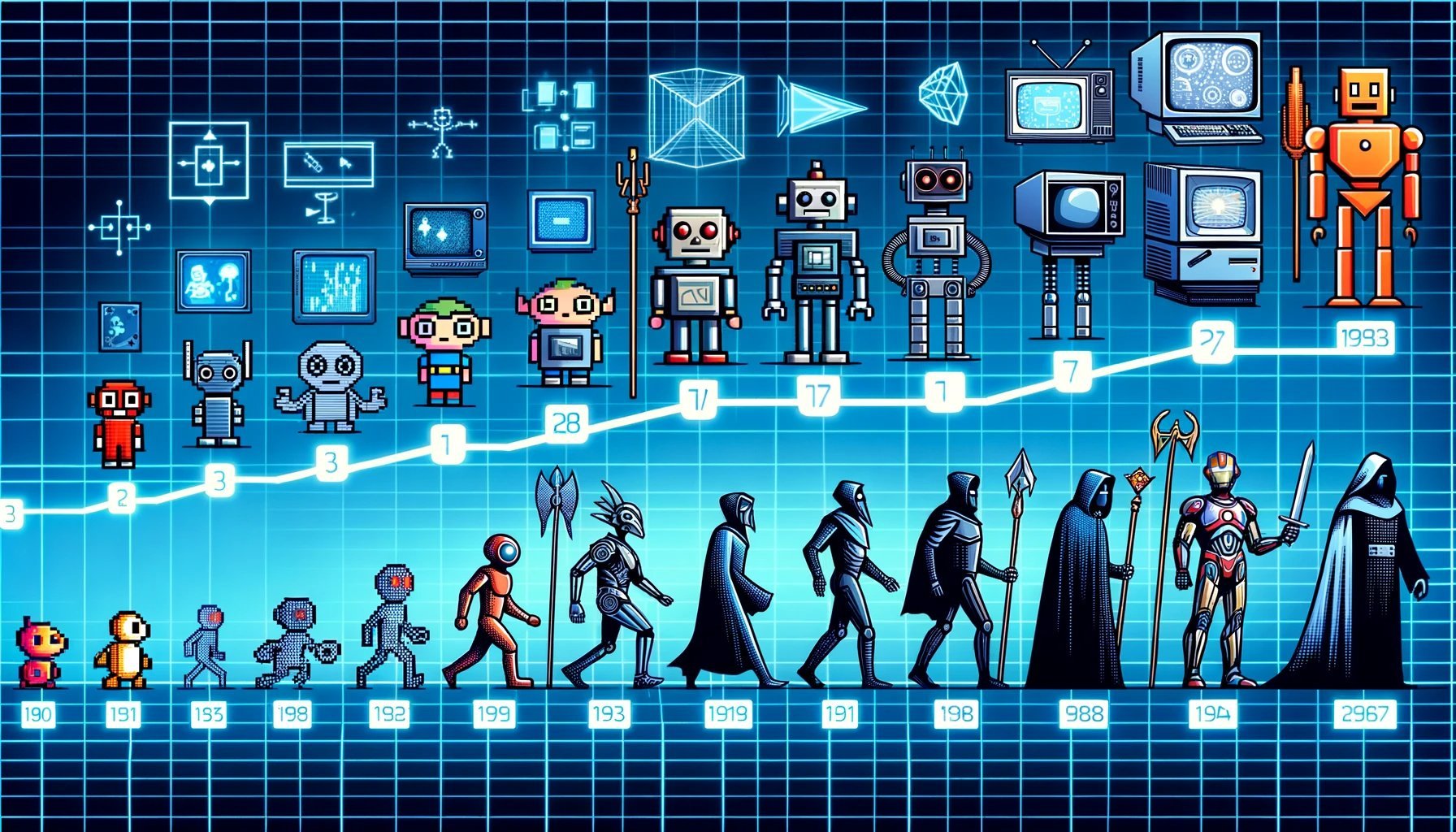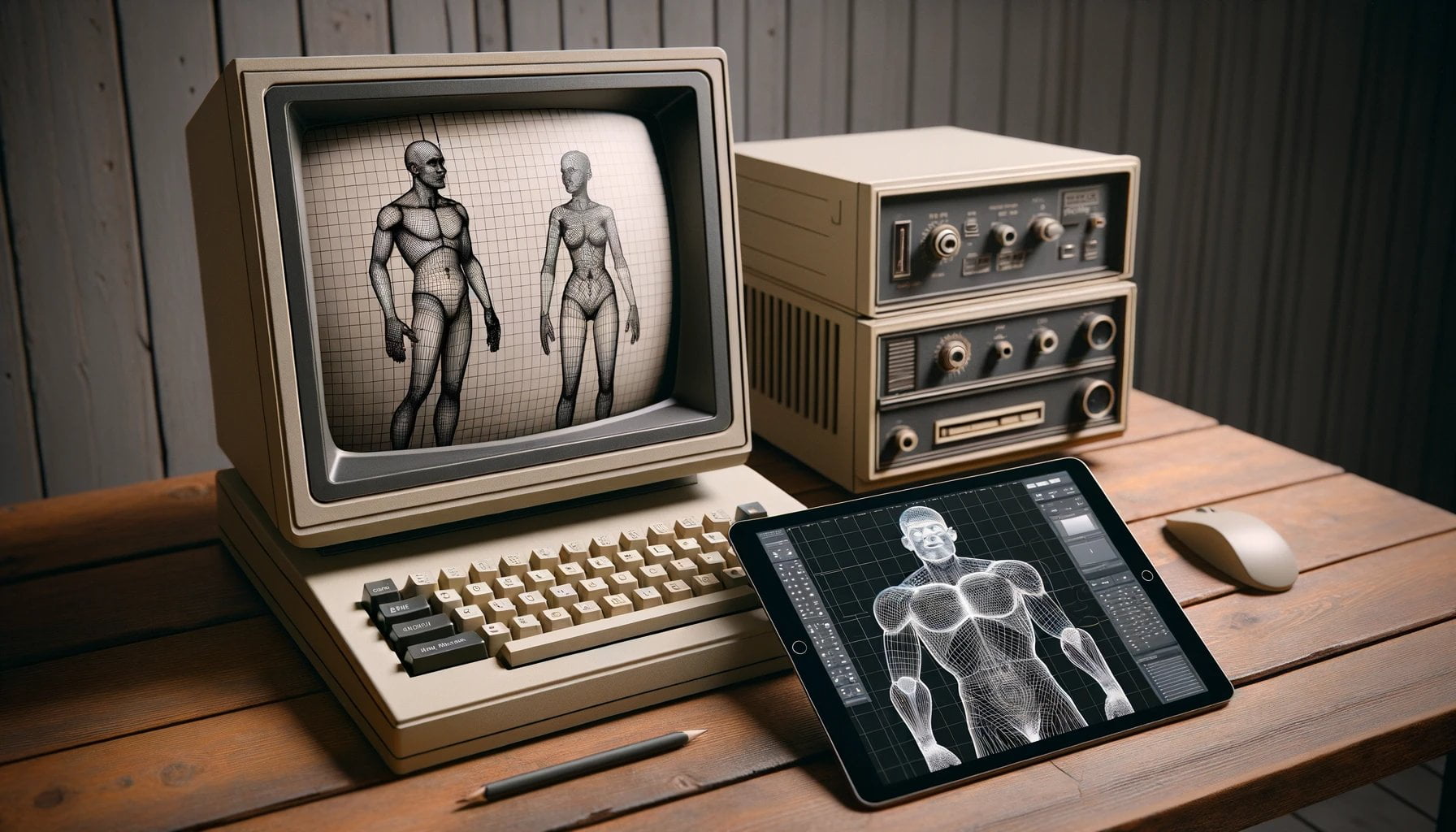The Captivating Evolution of Computer Animation: A Comprehensive History unveils the fascinating journey of computer animation, delving deep into its beginnings, breakthroughs, and remarkable transformations over time. This article dives into the captivating world where art and technology converge, tracing the origins of computer animation and exploring the pioneers, milestones, and innovative techniques that have shaped the field. Through a seamless blend of film and graphic design expertise, readers will embark on a mesmerizing exploration of the captivating evolution of computer animation.

Key Takeaways:
- Computer animation is a digital version of traditional stop motion animation.
- Computer graphics experimentation began in the 1940s for scientific and research purposes.
- John Whitney created the first computer animation in 1958 for the title sequence of Alfred Hitchcock’s Vertigo.
- Bell Telephone Laboratories played a significant role in developing computer animation in the 1960s.
- Early computer animations include “Hummingbird,” “Kitty,” and “Metadata.”
- The sequel to the 1973 film Westworld made notable advancements in computer animation for cinema.
Computer Animation History
Computer animation has come a long way since its humble beginnings in the 1940s. It has transformed from basic experiments in computer graphics to becoming an integral part of the entertainment industry. Let’s take a captivating journey through the comprehensive history of computer animation.
Early Exploits and Milestones
In the 1940s, scientists and researchers began exploring computer graphics for scientific and research purposes. However, it wasn’t until 1958 that computer animation made its grand debut on the big screen. John Whitney created the first-ever computer animation for the title sequence of Alfred Hitchcock’s thriller, “Vertigo.” This groundbreaking accomplishment marked the dawn of a new era in animation.
The Pioneers of Computer Animation
Throughout the 1960s, researchers at Bell Telephone Laboratories experimented with computer animation, pushing the boundaries of what was thought possible. These visionaries paved the way for future advancements in the field. With their innovative techniques and rigorous exploration, they set the stage for the future of computer animation.
Early Examples and Innovations
As computer animation continued to evolve, several noteworthy pieces emerged. “Hummingbird,” “Kitty,” and “Metadata” are just a few examples of early computer animations that showcased the potential of this emerging medium. These creations hinted at the mesmerizing possibilities of bringing imaginary worlds and characters to life using cutting-edge technology.
Computer Animation in Cinema
The cinematic landscape was forever changed by computer animation in the 1970s. One notable milestone was the release of the sequel to the 1973 film “Westworld.” It became an early example of how computer animation could be seamlessly integrated into live-action films, expanding the storytelling possibilities and captivating audiences around the world.
The Evolution Continues
As the years went by, computer animation continued to evolve at an incredible pace. Advancements in technology allowed for more complex and realistic animations. The birth of Pixar Animation Studios in the 1980s marked a turning point in the industry, as they revolutionized computer-generated imagery (CGI) and brought computer animation to new heights.
Conclusion
The captivating evolution of computer animation has taken us from simple experiments to spectacular creations that delight and inspire audiences worldwide. From the groundbreaking work of pioneers like John Whitney to the advancements made by studios like Pixar, computer animation has become an integral part of our lives, shaping the way we experience storytelling and visual art.
Through strategic utilization of technology and artistic vision, computer animation continues to push the boundaries of what is possible. As we look to the future, we can only imagine the awe-inspiring innovations that lie ahead. So let us celebrate the captivating history of computer animation and embrace the limitless potential it holds.
Animation history is a fascinating subject that takes us back in time to explore the evolution of this captivating art form. If you’re curious about the origins and development of animation, click here to delve into the rich world of animation history: animation history.
Technological Advancements That Revolutionized Computer Animation
The captivating evolution of computer animation has been driven by a series of groundbreaking technological advancements. These innovations have pushed the boundaries of what was once thought possible, transforming the world of animation and shaping the way we tell stories visually. From early experiments in the 1940s to the present day, let’s explore the key technological milestones that have revolutionized computer animation.
Early Experiments and the Rise of Digital Computers
In the 1940s and 1950s, pioneers like John Whitney and his brother James embarked on early experiments in computer animation. These visionaries laid the foundation for what was to come, showcasing the artistic potential of combining technology and creativity. However, it was not until the 1960s that digital computers became widely established, opening up new avenues for innovation in computer graphics.
The Role of Universities and Research Institutions
During the mid-1960s to mid-1970s, the University of Utah emerged as a significant player in the field of computer animation. This period saw the development of revolutionary techniques, including the creation of the first computer-drawn film by the Swedish Royal Institute of Technology in 1960. Meanwhile, Bell Labs in New Jersey made significant contributions, producing pioneering computer-generated films and developing animation systems.
Commercial Hardware and Software Advancements
The 1980s marked a turning point in the history of computer animation, as radical advancements in commercial hardware and software transformed the industry. The incorporation of framebuffer technologies into graphic workstations led to a great expansion of possibilities. Notable commercial software products, such as Autodesk Inc in 1982, emerged, empowering artists and animators with powerful tools to bring their visions to life.
The Arrival of 3D Wireframe Imagery and CGI
In 1976, the sequel to “Westworld,” titled “Futureworld,” introduced audiences to the first use of 3D wireframe imagery in mainstream cinema. This groundbreaking visual technique showcased the potential of computer animation in live-action films. As technology continued to advance, the 1980s saw the birth of Pixar Animation Studios, revolutionizing computer-generated imagery (CGI) and setting the stage for the future of animation.
The Rapid Expansion in Film and TV
The 1990s witnessed a rapid expansion of computer animation in the film and television industry. Blockbuster films like “Titanic,” “Jurassic Park,” and “Independence Day” showcased the transformative power of CGI, captivating audiences around the world. The decade also witnessed significant developments, mergers, and deals in the 3D software industry, contributing to the growth and evolution of computer animation.
Key Takeaways:
- The history of computer animation dates back to the 1940s, with early experiments paving the way for future advancements.
- The rise of digital computers in the 1960s opened up new possibilities for computer graphics and animation.
- Universities and research institutions, such as the University of Utah and Bell Labs, played pivotal roles in driving innovation.
- The 1980s saw a significant expansion in commercial hardware and software, empowering artists and animators.
- The adoption of 3D wireframe imagery and the birth of Pixar Animation Studios revolutionized CGI in the film industry.
- The 1990s witnessed a rapid expansion of computer animation in films like “Titanic” and major developments in the software industry.
Impact of Computer Animation in the Entertainment Industry
Computer animation has had a profound impact on the entertainment industry, revolutionizing the way stories are told and captivating audiences with stunning visual effects. From its humble beginnings in the 1940s and 1950s to the present day, computer animation has evolved into a powerful medium that has reshaped the landscape of cinema and television.
The Beginning of a New Era
The history of computer animation begins with pioneers like John Whitney Sr., who experimented with computer graphics in the 1950s. His collaboration with graphic designer Saul Bass on the animated title sequence for Alfred Hitchcock’s film Vertigo in 1958 marked a significant milestone in the field. This early work laid the foundation for the integration of computer animation into the entertainment industry.
Pushing Boundaries through Technology
Advancements in technology during the 1960s opened up new possibilities for computer animation. Researchers at Bell Telephone Laboratories pushed the boundaries of the medium, utilizing mainframe digital computers to explore the artistic potential of computer graphics. This experimentation laid the groundwork for further innovation in the following decades.
From Hummingbirds to Mainstream Cinema
Early examples of computer animation, such as “Hummingbird” and “Kitty,” showcased the artistic and storytelling potential of this emerging medium. These experimental films captivated audiences and demonstrated the unique capabilities of computer-generated imagery. With the release of the 1976 film “Futureworld,” featuring 3D wireframe imagery, computer animation made its way into mainstream cinema, leaving audiences in awe of the possibilities.
Revolutionizing Filmmaking
The 1980s saw a significant leap forward in commercial hardware and software, enabling more complex and realistic animations. Pixar Animation Studios, founded in the 1980s, revolutionized computer-generated imagery (CGI) and set the stage for the future of animation. Films like “Titanic,” “Jurassic Park,” and “Terminator 2: Judgment Day” showcased the transformative power of CGI, captivating audiences and setting new standards for visual effects in filmmaking.
Transforming Television and Beyond
Computer animation’s impact extends beyond the big screen. It has transformed television with shows like “The Iron Giant” and “Ratatouille,” bringing imaginative worlds to life and captivating audiences of all ages. Additionally, computer animation has found its way into video games, advertising, and other forms of media, enhancing the overall entertainment experience.
Key Takeaways:
- Computer animation has revolutionized the entertainment industry, reshaping the way stories are told and captivating audiences with visually stunning effects.
- Pioneers like John Whitney Sr. and collaborations with graphic designers laid the foundation for computer animation’s integration into the entertainment industry.
- Advancements in technology during the 1960s opened up new possibilities for computer animation, pushing the boundaries of the medium.
- Early examples of computer animation demonstrated the artistic and storytelling potential of the medium.
- The 1980s saw significant advancements in hardware and software, revolutionizing CGI and setting new standards for visual effects in filmmaking.
- Computer animation has transformed television, video games, advertising, and other forms of media, enhancing the overall entertainment experience.
5. Current trends and future prospects of computer animation
Computer animation has come a long way since its beginnings, constantly evolving and pushing the boundaries of what is possible. As technology continues to improve, the animation industry is experiencing significant advancements in quality and design, resulting in better visual effects that captivate audiences.
One notable trend in computer animation is the shift towards creating TV show programs for adults. This indicates a departure from animation primarily being targeted at children and showcases the versatility and wide appeal of the medium. Adults are increasingly drawn to animated storytelling and are embracing the diverse narratives and artistic expressions that computer animation offers.
Another important trend in the industry is the adoption of procedural workflows. Procedural workflows are becoming more mainstream, leading to increased efficiency and productivity in animation production. By automating certain tasks and utilizing algorithms, animators can focus more on creativity and storytelling, ultimately delivering high-quality animations in less time.
The pursuit of hyperrealism is another dominant trend in computer animation. Advancements in CGI and animation techniques have made it possible to create films that are visually indistinguishable from reality. This hyperrealistic approach immerses viewers in lifelike visual experiences, blurring the lines between fantasy and reality.
Looking ahead, the future of computer animation lies in the integration of machine learning. AI algorithms have the potential to reshape the animation process, providing assistance in the creation and animation process. With machine learning, animators can automate repetitive tasks, generate lifelike simulations, and even enhance character movements. This technology opens up exciting possibilities for more efficient and innovative animation production.
In addition, brands and artists are increasingly leveraging the popularity and versatility of animation as a medium. They are choosing animated videos to communicate their messages and captivate audiences. Animation allows for limitless creativity and can blend seamlessly with live-action footage or graphic design elements, offering a unique and engaging visual experience.
Key Takeaways:
– The animation industry is continuously evolving, with advancements in technology driving improvements in quality and design.
– The creation of TV show programs for adults indicates a shift in target audiences, showcasing the versatility and wide appeal of computer animation.
– Procedural workflows are becoming more mainstream, leading to increased efficiency and productivity in animation production.
– Hyperrealism is a dominant trend, with animations becoming more lifelike and visually indistinguishable from reality.
– The future of computer animation lies in the integration of machine learning, bringing automation and innovation to the animation process.
– Brands and artists are leveraging the popularity and versatility of animation as a medium for communication and captivating storytelling.
With these current trends and future prospects, computer animation is poised to continue captivating audiences and pushing the boundaries of visual storytelling. As technology evolves and creativity flourishes, we can expect even more exciting innovations in the field of computer animation.

FAQ
Q1: When did the history of computer animation begin?
A1: The history of computer animation began in the 1940s and 1950s when people started experimenting with computer graphics.
Q2: Who is considered one of the fathers of computer animation?
A2: John Whitney Sr. is widely considered one of the fathers of computer animation, known for his experimental films and motion control photography.
Q3: What was the first digital image created and when?
A3: The first digital image was created in 1957 by computer pioneer Russell Kirsch and his team.
Q4: What advancements in commercial hardware occurred in the 1980s?
A4: The 1980s saw a great expansion of radical new developments in commercial hardware, including the incorporation of framebuffer technologies into graphic workstations.
Q5: What notable films showcase computer animation?
A5: Notable films that showcase computer animation include Titanic, Jurassic Park, Independence Day, Ratatouille, Willow, Vertigo, The Little Mermaid, The Iron Giant, Twister, and Terminator 2: Judgment Day.
- Unveiling the Enigma: Mansoureh Khojasteh Bagherzadeh’s Public Appearances & Private Life in Iran - July 18, 2025
- Unveiling the Mystery: Mansoureh Khojasteh Bagherzadeh’s Husband: A Rare Glimpse into a Private Life - July 18, 2025
- Unveiling Masoud Khamenei’s Mother: Power, Influence, and Iran’s Future - July 18, 2025
















